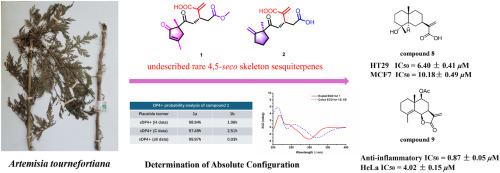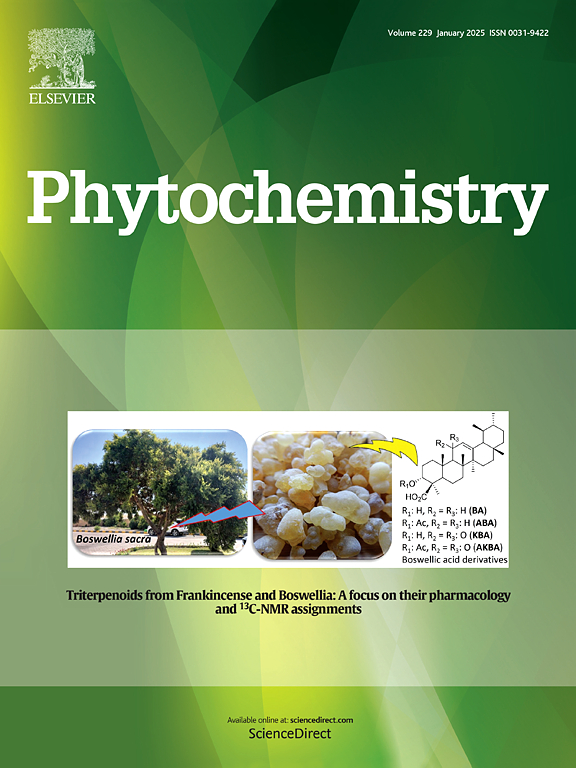黄花蒿中重排芥子烷型倍半萜的发现。
IF 3.4
2区 生物学
Q2 BIOCHEMISTRY & MOLECULAR BIOLOGY
引用次数: 0
摘要
从金针蒿中分离得到6个未描述的倍半萜类化合物artetourneforin F-K(1-6)和6个已知化合物(7-12)。通过一维和二维核磁共振光谱数据、hresms、ECD和量子化学计算确定了它们的结构。Artetourneforin F-K(1-6)代表了天然倍半萜中罕见的4.5秒未描述骨架,并提出了一种合理的生物合成途径。化合物7和8的x射线晶体结构为首次报道。化合物9对HeLa细胞株具有极显著的抗炎和细胞毒活性,IC50值分别为0.87±0.05 μM和4.02±0.15 μM。在抗白癜风活性试验中,化合物8和10显示出促进B16F10细胞黑色素生成的活性。化合物8对HT29和MCF7细胞株具有显著的细胞毒性,IC50值分别为6.40±0.41和10.18±0.49 μM。本文章由计算机程序翻译,如有差异,请以英文原文为准。

Discovery of rearranged eudesmane-type sesquiterpenes from Artemisia tournefortiana
Six undescribed sesquiterpenes artetourneforin F–K (1–6), along with six known compounds (7–12), were isolated from Artemisia tournefortiana. Their structures were established by 1D and 2D NMR spectroscopic data, HRESIMS, ECD, and quantum chemical calculations. Artetourneforin F–K (1–6) represented a rare 4,5-seco undescribed skeleton in natural sesquiterpenes, and a plausible biosynthetic pathway was proposed. The X-ray crystal structures of compounds 7 and 8 were reported for the first time. Compound 9 showed extremely significant anti-inflammatory and cytotoxicity activity against HeLa cell lines with IC50 values of 0.87 ± 0.05 μM and 4.02 ± 0.15 μM, respectively. In the anti-vitiligo activity test, compounds 8 and 10 demonstrated activity in promoting melanogenesis in B16F10 cells. Compound 8 exhibited significant cytotoxicity against the HT29 and MCF7 cell lines, with IC50 values of 6.40 ± 0.41 and 10.18 ± 0.49 μM, respectively.
求助全文
通过发布文献求助,成功后即可免费获取论文全文。
去求助
来源期刊

Phytochemistry
生物-植物科学
CiteScore
6.40
自引率
7.90%
发文量
443
审稿时长
39 days
期刊介绍:
Phytochemistry is a leading international journal publishing studies of plant chemistry, biochemistry, molecular biology and genetics, structure and bioactivities of phytochemicals, including ''-omics'' and bioinformatics/computational biology approaches. Phytochemistry is a primary source for papers dealing with phytochemicals, especially reports concerning their biosynthesis, regulation, and biological properties both in planta and as bioactive principles. Articles are published online as soon as possible as Articles-in-Press and in 12 volumes per year. Occasional topic-focussed special issues are published composed of papers from invited authors.
 求助内容:
求助内容: 应助结果提醒方式:
应助结果提醒方式:


